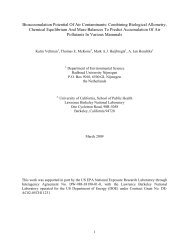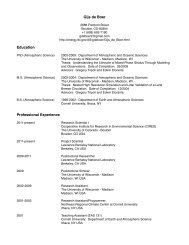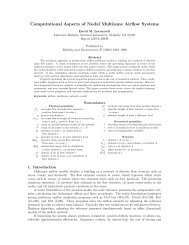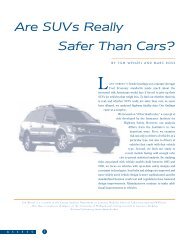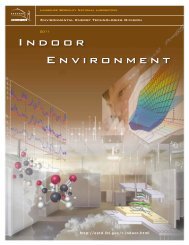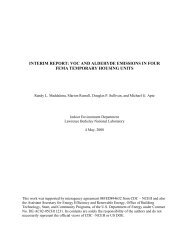indoor-outdoor air leakage of apartments and commercial buildings
indoor-outdoor air leakage of apartments and commercial buildings
indoor-outdoor air leakage of apartments and commercial buildings
Create successful ePaper yourself
Turn your PDF publications into a flip-book with our unique Google optimized e-Paper software.
warehouses tend to be leakier than average. At a 50 Pa <strong>indoor</strong>-<strong>outdoor</strong> pressure<br />
difference, a typical building <strong>of</strong> a "leaky" building category might experience <strong>air</strong> flow<br />
about 20 to 40% higher per unit area <strong>of</strong> building envelope than a building in a "tight"<br />
building category.<br />
3. For a given building category, <strong>buildings</strong> with small "footprints" (i.e. small ro<strong>of</strong> area),<br />
under 1000 m 2 , tend to be 25% to 50% leakier, per unit envelope area, than <strong>buildings</strong><br />
with large footprints. Large-footprint areas tend to have a higher fraction <strong>of</strong> their total<br />
envelope area in the form <strong>of</strong> their ro<strong>of</strong>, so if ro<strong>of</strong>s are tighter than walls then we would<br />
expect the leakiness per unit <strong>of</strong> envelope area to decrease with footprint size. It is also<br />
possible that a substantial <strong>leakage</strong> path is the joint between walls <strong>and</strong> ro<strong>of</strong>, which<br />
increases only linearly with building footprint whereas envelope area increases<br />
quadratically; this, too, is a possible explanation for the decrease <strong>of</strong> leakiness per unit<br />
envelope area as the footprint increases.<br />
4. For a given building category, taller <strong>buildings</strong> appear to be slightly tighter than shorter<br />
<strong>buildings</strong> (with single-story <strong>buildings</strong> being perhaps 10% to 25% leakier than taller<br />
<strong>buildings</strong>, per unit envelope area), but (a) the scarcity <strong>of</strong> tall <strong>buildings</strong> in the database<br />
gives us little statistical power to address this issue, <strong>and</strong> (b) almost all <strong>of</strong> the tall<br />
<strong>buildings</strong> are <strong>of</strong>fice <strong>buildings</strong>, so we cannot distinguish a height effect from an effect <strong>of</strong><br />
building type (item 2). Visual inspection <strong>of</strong> Figure 7 may suggest that taller <strong>buildings</strong> are<br />
much tighter, but this is largely illusory: there are so many more data points from the<br />
single-story category that (in terms <strong>of</strong> absolute numbers) most <strong>of</strong> the leaky <strong>buildings</strong><br />
have a single story.<br />
5. For <strong>buildings</strong> <strong>of</strong> a given construction type <strong>and</strong> activity category, leakiness per unit<br />
envelope area is approximately lognormally distributed, with a GSD between about 1.7<br />
<strong>and</strong> 2.2.<br />
To the extent that the category <strong>of</strong> activity in the building is related to building leakiness, this is<br />
presumably because the building activity category is a proxy for unknown or unspecified<br />
construction methods <strong>and</strong> design features, rather than due to a causal relationship between<br />
activities <strong>and</strong> leakiness. For instance, the design <strong>and</strong> construction details <strong>of</strong> metal-frame strip<br />
malls tend to differ from metal-frame <strong>of</strong>fice <strong>buildings</strong> in systematic ways, so it makes sense that<br />
metal-frame strip malls tend to have different <strong>leakage</strong> characteristics than metal-frame <strong>of</strong>fice<br />
<strong>buildings</strong>. However, if a strip mall were converted into <strong>of</strong>fices, we would expect its <strong>leakage</strong> to<br />
be similar to that <strong>of</strong> strip malls, not <strong>of</strong>fice <strong>buildings</strong>. As a result, we are not able to predict what<br />
might occur for combinations <strong>of</strong> construction methods <strong>and</strong> building usage categories that are<br />
not in our data. It is not clear that, say, a curtain-wall public assembly building would in fact be<br />
particularly tight, even though other curtain-wall <strong>buildings</strong> appear to be tight, <strong>and</strong> public<br />
<strong>buildings</strong> tend to be tight, since a curtain-wall public assembly building would probably differ<br />
greatly in design from all <strong>of</strong> the other public assembly <strong>buildings</strong> <strong>and</strong> curtain wall <strong>buildings</strong> in<br />
our database.<br />
The Commercial Buildings Energy Consumption Survey (CBECS), a Department <strong>of</strong><br />
Energy data collection effort, characterizes the <strong>commercial</strong> building stock <strong>of</strong> the United States in<br />
a variety <strong>of</strong> ways (ErA, 2003). As with our definition <strong>of</strong> "<strong>commercial</strong>" for purposes <strong>of</strong> this<br />
report, CBECS includes many <strong>buildings</strong> that are not places <strong>of</strong> business: its sampling frame<br />
29



